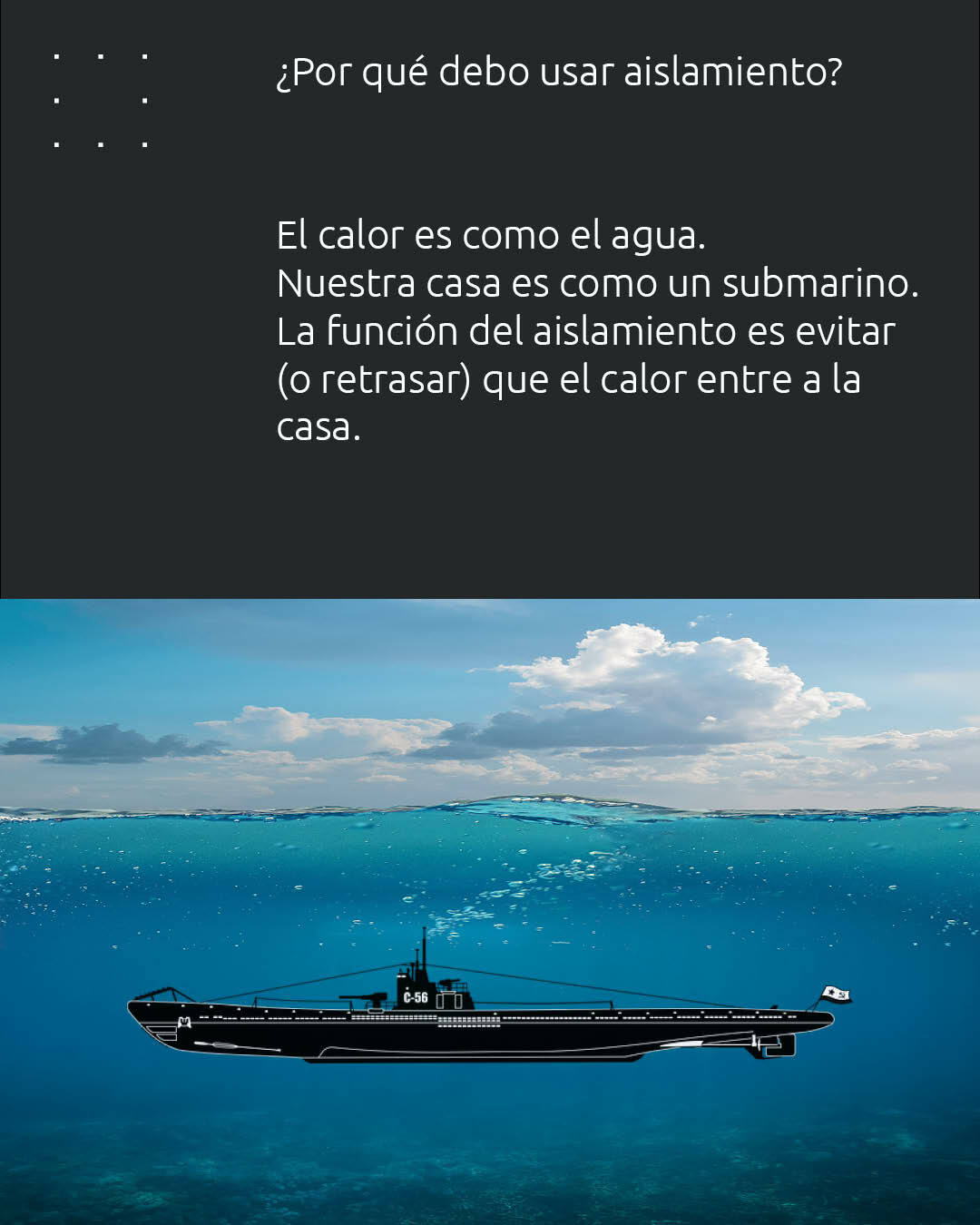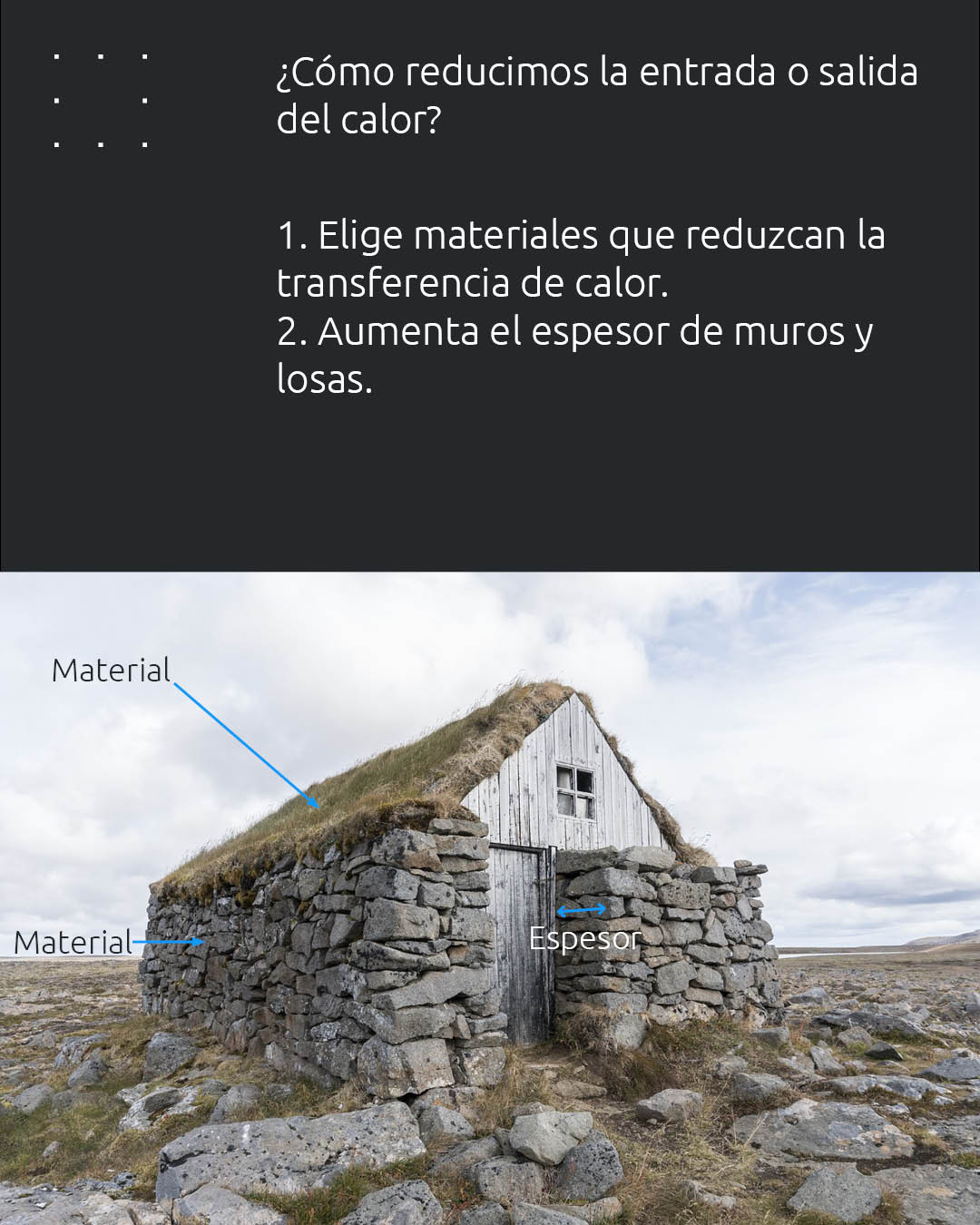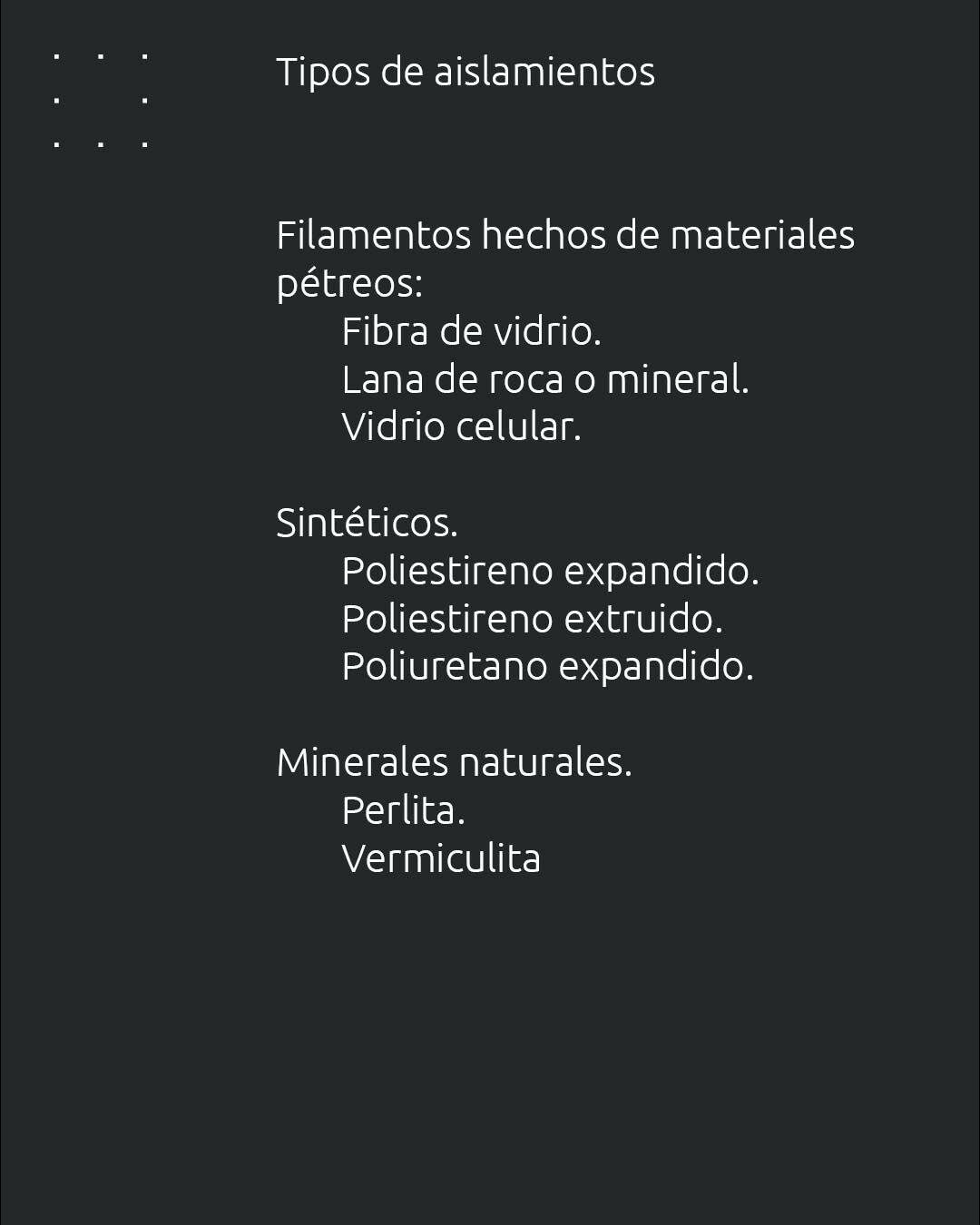I start by answering the question in the title. How can I make my house cooler, or if I live in a cold area, how can I make it warmer?
There is more than one way to achieve this. In the title I already advance one of them. Insulation. It is the technique that I am going to talk about in this post.

Does my house need insulation?
If you are looking for the quick answer, it’s yes. In most cases it is a resounding yes.
It is very likely that now you are wondering why. I’m sure that a simple yes is not enough to convince you. Especially, considering that installing insulation is an expense.
Why does it need insulation?
I need to explain the theory. Wait, don’t skip this part. It will be a very light explanation. I won’t talk about entropy, although it wouldn’t be bad… maybe in another post.
I’ll start by telling you about heat. This is nothing more than a type of energy. Simple as that. And so complex. Consequently, cold is the absence of energy.
To understand it better, let’s imagine that heat is water. Let’s create two scenarios.
In the first, we live in a cold place. In this, our house behaves like a cistern. What we want is to store water (heat). We have the problem that there is no way to contain it. It always ends up leaking, whatever material our cistern is made of. And it does it everywhere: through the roof, through the floor, through the walls, through the doors and through the windows. What we are looking for is that the materials with which we build the house (or cistern) reduce, as much as possible, the infiltration of water (heat).
In the second scenario we live in a warm place. Now our house is acting like a submarine. What we want is to keep water (heat) out. As in the previous case, it leaks everywhere. And, unlike a normal submarine, there’s no way to stop it from doing so. What we are looking for is the same as in the first scenario: reduce heat leaking. This is the function of insulation.

How do we reduce leakage?
Or rather, how do we slow it down? Let’s not forget that there is no way to stop it completely. Well, actually, there is. But I’ll talk about that later. And it’s in a way you can’t imagine.
For now, let’s get back to our question. There are two ways to achieve it.
The first is to choose a material that reduces heat transfer. Each material has different capacity, which depends on its physical properties. It does not change if the transmission goes from inside to outside or vice versa.
The second way is to increase the distance the heat must travel, that is, the thickness. A 60 cm wall has three times more capacity to resist the passage of heat than a 20 cm one.

After knowing that we can use both factors to reach our goal, the next step is to find out how much of each to take. There is a question that can help us understand this. If I have a layer of insulation layer of a certain thickness, what thickness do I need of another material to get the same resistance to the passage of heat? The answer is in the following graph. What it shows is a comparison of common building materials of different thickness, all with the same resistance as a 38 mm insulation layer. The values that we took are typical and vary depending on factors such as density or water content.
What the graphic teaches us is that the differences are huge. There are bad materials to stop heat like concrete or stones. There are others that come close to the levels of insulators. Metals reach so low levels that they are called heat conductors.

Why are many houses without insulation?
I want to tell you a little history to explain the reason for my resounding yes to using insulation.
Hasta finales del siglo XIX, el acero y el concreto no se utilizaban en ningún lugar del mundo. Al menos no en la forma moderna en que se usan ahora. Seguro te has dado cuenta. Casi todo se construía con algún tipo de piedra, madera o tierra.
The masonry walls, like those of stone or brick, have a limitation. They must be thick so as not to turn over In another post I will tell you why this is. Although it was expensive to build in this way, there was a benefit. Yes, you guessed it. Their thickness allowed them to better resist the passage of heat.
Have you ever been in an old house with huge walls? Have you noticed the pleasant temperature they have? At least better than those made of concrete.
The introduction of steel gave the walls greater structural capacity. Builders were able to make them thinner without them tipping over. If you wonder where the steel goes: It is usually embedded within the walls or the concrete structure that confines them.
Making them thinner allowed to save on material and space. Which was fantastic. The thick and expensive walls were no longer necessary. But, there are times when a discovery brings with it a new problem. They stopped working as insulators. The consequence was the use of fuel to heat houses. That was done long ago with fireplaces. But this time it was used for heating and air conditioning. The richer countries were filled with these devices.
The problem returned with the progressive increase in the cost of fuel. It was necessary to go back to thick walls. However, an innovation made new forms of construction possible. It was modern insulating materials. With them, it was possible to build thin walls and, at the same time, protect the interiors from outside temperatures. The best of both worlds.
Why is insulation not used in Mexico and other Latin American countries?
Does your house have insulation? If your answer was no, it is most likely made with concrete walls or slabs. What happened in this part of the world? Here, building skins were modernized by reducing their thickness. What never came was the rectification, that is, the return to the thick walls. That was combined with the fact that very few households could afford the devices that control the indoor climate.
The main reason why this happened is obvious, lack of resources.
The Mexican case is special. The center of the country has a relatively mild climate compared to other places. Therefore, there is less awareness to insulate buildings. This is also the region where a good part of the construction professionals have been trained. Their diaspora has spread their lack of concern for insulation throughout the country. Even to regions with extreme climates.
We have no data to confirm the latter. But we believe it is not just about economic factors. The good news is that this is changing.
What has been the consequence?
For those with money, overspending on heating or air conditioning.
For those without, deterioration of their quality of life and health.
These consequences also impact regions with mild climates. Who has not suffered cold or heat inside their home? Sometimes it gets to the point that the temperature is better outside. Countries that insulate their homes tend to enjoy greater comfort, even in extreme climates.
Or to the absurdity that there are places with good construction practices, which have better conditions even in extreme climates.
Personally, it saddens me sad every time I see populations with a good constructive tradition opt for the practices we criticize here.

What if I prefer to pay the air conditioning?
There is one more reason why you should use insulation. To explain it I have to go back to the submarine.
In our example the water (the heat) was leaking everywhere. Of course, we can install a pump to remove it. The pump is the air conditioning. This works. With due cost we managed to get the heat out. What we do not prevent is that the walls are damp, that is, that they are hot. The air temperature is cold, but the walls are hot. This heat radiates in the form of waves, reducing the feeling of comfort.
When our house works like a cistern something similar happens. In this case what we have are cold walls. Surely you have suffered this sensation. The indoor climate is good. But as soon as you get close to a wall or a window you feel the discomfort of the outside temperature.
I can give you one more reason to avoid dependance on air conditioners. This is climate change. These devices consume excessive amounts of energy. In other words, they are very polluting. In another post I will talk about this in depth. For now it is enough that you know it.

What about windows and doors?
The graph showed us that the insulating capacity of wood is good. It reaches one of the highest levels among common building materials. The problem is that it is usually used in the form of very thin sheets. Glass sheets are also usually very thin. The result is that doors and windows become the points with the greatest heat leakage. To avoid this, double glazing is used. In the case of doors, they are filled with insulation.
¿Recuerdas que te iba a contar cómo detener la conducción del calor? La manera es interponiendo vacío. Sí, leíste bien. Pero hacer un muro de vacío es un poco complicado. Hay una alternativa que se le asemeja. Aunque, al final no impide el paso del calor. Esta es el aire. No suena lógico que este sea el mejor aislante. La razón es que el calor emplea la materia como medio por el que circula de un lado a otro. En el aire hay menos de ella. Sin embargo, hay una condición para que sea un buen aislante. Si no la cumplimos no nos sirve. Esta es que esté estático, es decir, que no se mueva. ¿Cómo logramos esto? Tenemos que contenerlo en espacios muy pequeños. Las ventanas de doble acristalamiento funcionan porque la distancia entre los cristales es muy reducida. Los materiales aislantes son básicamente aire contenido. Se componen de diminutos compartimentos con aire en su interior. Por eso son tan ligeros.
Before starting to talk about insulation materials, it is important to finish this topic. It is crucial that you know that it does not make sense to insulate walls and slabs if you don’t do the same with windows and doors. Remember that a house is like a cistern or a submarine. We must not leave a hole through which water can enter or exit.
Do you remember our history about how insulation came about? It’s time to tell you the last part. Walls became thin and then grew again. Something similar happened to the windows. In the past, only very small panes of glass could be made. This prevented having large windows. Except maybe the stained-glass windows. Technological development allowed to increase the size of the glass sheets. With it, that of the glazed windows. The result was that passage of heat through the façade was accelerated. The correction was the appearance of double or even triple glazed windows.

What are the insulating materials?
The list is long, but I will name a few:
- Fiberglass.
- Rock or mineral wool.
- Cellular glass.
- Expanded polystyrene.
- Extruded polystyrene.
- Expanded polyurethane.
- Polyisocyanurate.
- Expanded perlite.
- Vermiculite.
If you are not familiar with insulating materials, these names may mean anything to you. In general, we can distinguish them by their origin:
The first three are filaments made from stone materials. All those beginning with poly are synthetic. The latter are natural minerals.
They are also distinguished by their format. Some may be rigid plates. Others look like blankets. There are also those that are installed as foams. Finally, some are loose fibers or pellets.

What insulating material should I use in my house?
The answer depends on several factors.
First you must know if you want to install it inside, outside, or in the middle of the wall. There are materials that don’t work exposed to the elements. There are others that have to be contained.
Another factor is its fire performance.
Finally, the cost of the material and its installation.
It’s important that you review all these factors for your particular case.

How much does the cost of a wall increase with the insulation?
To give you an answer, we review the cost of some materials and solutions in Mexico.
In doing so we focused on rock wool, fiberglass and polystyrene applied to the exterior of the walls. This is the system known as EIFS or ETICS (Exterior Insulation Finishing System or External Thermal Insulation Composite Systems).
Insulation can also be installed inside, which can reduce costs, but we prefer it outside. This is due to the lower risk of condensation within the wall.
As for the substrate material, we reviewed concrete block, brick, timber and galvanized profiles.
It is important to keep in mind that prices vary depending on several factors. Examples are the type of substrate, the insulating material, the thickness and the density of the latter. Another factor, as I mentioned before, is the position of the insulation layer on the wall. There are also variations with the location and its conditions. Additionally, prices change depending on when the materials are purchased. In the case of roof insulation, the proportion of the cost of the insulating material is reduced. This is because slabs are usually more expensive than walls.
After this huge introduction I give you the answer. The increase ranges from 35% to 300%. I know, the range is large. Let me give you an example. A substrate made of brick, framed with concrete; with 38 mm rock wool insulation, gave us an increase of around 200%. In other words, the cost of the wall doubled.
Does it seem expensive to you? In reality, spending evens out over time. This thanks to savings in air conditioning and heating. Besides gains in life quality and health.
Factors to take care of for its installation.
Before finishing, I’ll give you some recommendations.
It is important that your architect of specialist solve the insulation detail correctly. There are companies that sell complete solutions. Some of the problems to foresee are:
Water leaks around doors, windows and joints between elements.
Thermic bridges, that is, passage of heat through points where the insulation was not given continuity.
In the case of insulation installed on the exterior; water penetration inside the wall without being allowed to escape.
Also, in the case of insulation installed on the exterior; cracks in the insulation layer due to changes in the substrate material.
When installing insulation on the interior; condensation inside the walls.
The quality of the work during construction.
As a conclusion.
The purpose of this post is to show you the importance of using insulation. When we decide to buy any good, we evaluate its costs and benefits. We rarely go for the cheapest if it doesn’t meet our needs. The same goes for the house. Walls and roofs exist primarily to protect you rather than as support elements. When they do not insulate from the weather, they don’t fulfill their most essential function. Therefore, they shouldn’t be your choice when building your home.